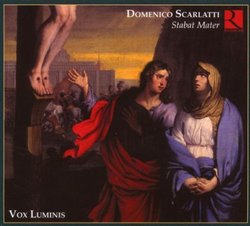Another Choice! and a Good One...
Giordano Bruno | Wherever I am, I am. | 03/24/2009
(5 out of 5 stars)
"I've already reviewed, very enthusiastically, the performance of D. Scarlatti's 10-voice polyphonic Stabat mater by the ensemble Concerto Italiano, Rinaldo Alessandrini conducting. Here's the heart of that review:
"Alessandro Scarlatti's setting of the Stabat Mater is a model of Baroque emotional expressiveness, essentially an operatic cantata, with the sectional variety of recitations and arias over basso continuo that Vivaldi had employed in his earlier setting and that Pergolesi was soon to use in his. Whether Domenico Scarlatti intended his remarkable Stabat Mater for Ten Voices to be taken as a sign of his independence from the model of his father, or a response to a commission from the Duke of Alba, or a challenge to the 'theatrical' composers of the musical moment who lacked 'the true laws of writing in counterpoint,' the younger Scarlatti chose to compose in the strictest "prima prattica" style of vocal polyphony with minimum continuo, a form of music closer to Palestrina or Brumel than to his 18th Century peers. The ten voices are not even grouped into two choirs in the antiphonal manner of Gabrieli, and they double up as a choir of five parts only for brief sectional emphasis. Young Domenico clearly seems to have intended to prove something; this is true ten-part polyphony that any Renaissance master would have had to admire."
This performance by the ensemble Vox Luminis is every bit as good as the one by Concerto Italiano. The tempi are brighter and thus the 'affect' is perhaps less spiritually intense, but the musicianship is top notch. The other works that fill out the Vox Luminis CD are different and more varied, though to my ears they're less impressive as compositions than the 4-voice Missa sung by Concerto Italiano. One reviewer of this Vox Luminis CD declares that he wishes Domenico Scarlatti had written more vocal music and fewer keyboard sonatas. At the risk of having every pianist in the Netherlands screaming for my scalp, I find that I agree.
I've given myself the pleasant task of surveying the great Stabat Mater settings of the 18th Century - by Vivaldi, Alessandro Scarlatti, Pergolesi, Bononcini, Boccherini, and Haydn - all of them works for solo voice or voices with instrumental support. You'll find my reviews of the most satisfactory performances in all the appropriate places:
1. Vivaldi - Stabat Mater - Ensemble 415
2. A. Scarlatti - Stabat Mater - Il Seminario Musicale
3. Pergolesi - Stabat Mater - Il Seminario Musicale
4. Caldara - Stabat Mater - Aura Musicale & Coro della Radio Svizzera Italiana
5. Boccherini - Stabat Mater - Ensemble 415
6. Domenico Scarlatti - Concerto Italiano
7. Giovanni Felice Sances - Philippe Jaroussky with Ens. Artaserse (CD: Beata Vergine)"
An ear-opening recording
L. Stanley | Minnesota, USA | 02/06/2008
(5 out of 5 stars)
"I'm always excited when I run across a new early music ensemble such as this. The Stabat Mater is simply spectacular. It's performed with 10 singers, which means one voice per part. This is not your typical OVPP performance of a choral piece, but rather an approach which makes a good case for this being a work intended for 10 solo voices. The piece is not for double choir - it has 10 independent parts (SSSSAATTBB). With one voice on each, it's possible to hear each individual voice clearly and really showcase Scarlatti's mastery of counterpoint. Other recordings I've heard are very top-heavy and the sopranos tend to drown out the other voices. Also, using OVPP allows the performance to be very energetic, in a way that simply can't be done with 20+ singers. Listen to the "Inflammatus" and "Fac Ut Animae" sound samples to see what I mean. These singers are top notch and I'm really looking forward to future recordings from this young ensemble.
As for the rest of the CD, the performances are solid but the pieces themselves are more subdued. The Te Deum is nice. I'm not really sold on the keyboard sonatas being performed on organ. The Stabat Mater is the title piece and really the one to listen for on this CD. If you've never heard Scarlatti's choral works before, you're definitely in for a treat. If you have, then you're also in for a treat with this extraordinary new ensemble. Either way, you may find yourself wishing Scarlatti had spent less time writing sonatas and more writing choral music!
"


 Track Listings (19) - Disc #1
Track Listings (19) - Disc #1